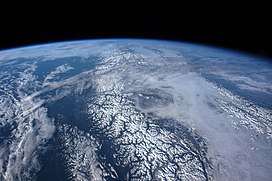| Coast Mountains | |
|---|---|
| Coast Range | |
 Coast Mountains taken from the International Space Station from outer space, the Canadian Rockies can be seen at the right | |
| Highest point | |
| Peak | Mount Waddington, British Columbia |
| Elevation | 4,019 m (13,186 ft) |
| Coordinates | 51°22′30″N 125°15′30″W / 51.37500°N 125.25833°W |
| Dimensions | |
| Length | 1,600 km (990 mi) north–south |
| Width | 300 km (190 mi) east–west |
| Area | 336,962 km2 (130,102 sq mi) |
| Geography | |
| Countries | Canada and United States |
| Region(s) | Alaska, British Columbia and Yukon |
| Range coordinates | 54°N 128°W / 54°N 128°W |
| Parent range | Pacific Coast Ranges |
The Coast Mountains (French: La chaîne Côtière) are a major mountain range in the Pacific Coast Ranges of western North America, extending from southwestern Yukon through the Alaska Panhandle and virtually all of the Coast of British Columbia south to the Fraser River.[1] The mountain range's name derives from its proximity to the sea coast, and it is often referred to as the Coast Range.[2] The range includes volcanic and non-volcanic mountains and the extensive ice fields of the Pacific and Boundary Ranges, and the northern end of the volcanic system known as the Cascade Volcanoes. The Coast Mountains are part of a larger mountain system called the Pacific Coast Ranges or the Pacific Mountain System, which includes the Cascade Range, the Insular Mountains, the Olympic Mountains, the Oregon Coast Range, the California Coast Ranges, the Saint Elias Mountains and the Chugach Mountains. The Coast Mountains are also part of the American Cordillera—a Spanish term for an extensive chain of mountain ranges—that consists of an almost continuous sequence of mountain ranges that form the western backbone of North America, Central America, South America and Antarctica.
The Coast Mountains are approximately 1,600 kilometres (1,000 mi) long and average 300 kilometres (190 mi) in width.[2] The range's southern and southeastern boundaries are surrounded by the Fraser River and the Interior Plateau while its far northwestern edge is delimited by the Kelsall and Tatshenshini Rivers at the north end of the Alaska Panhandle, beyond which are the Saint Elias Mountains, and by Champagne Pass in the Yukon Territory.[3][4] Covered in dense temperate rainforest on its western exposures, the range rises to heavily glaciated peaks, including the largest temperate-latitude ice fields in the world. On its eastern flanks, the range tapers to the dry Interior Plateau and the subarctic boreal forests of the Skeena Mountains and Stikine Plateau.
The Coast Mountains are part of the Pacific Ring of Fire—the ring of volcanoes and associated mountains around the Pacific Ocean—and contain some of British Columbia's highest mountains. Mount Waddington is the highest mountain of the Coast Mountains and the highest that lies entirely within British Columbia, located northeast of the head of Knight Inlet with an elevation of 4,019 metres (13,186 ft).[5]
- ^ BC Names/GeoBC entry "Coast Mountains"
- ^ a b "BCGNIS Query Results". Government of British Columbia. Retrieved 2008-11-13. [dead link]
- ^ S. Holland, Landforms of British Columbia, Province of British Columbia, 1976, pp 41 Archived March 4, 2016, at the Wayback Machine
- ^ map from Bulletin 48: Landforms of British Columbia Archived March 3, 2016, at the Wayback Machine
- ^ "BCGNIS Query Results". Government of British Columbia. Archived from the original on 2007-08-15. Retrieved 2008-11-13.
